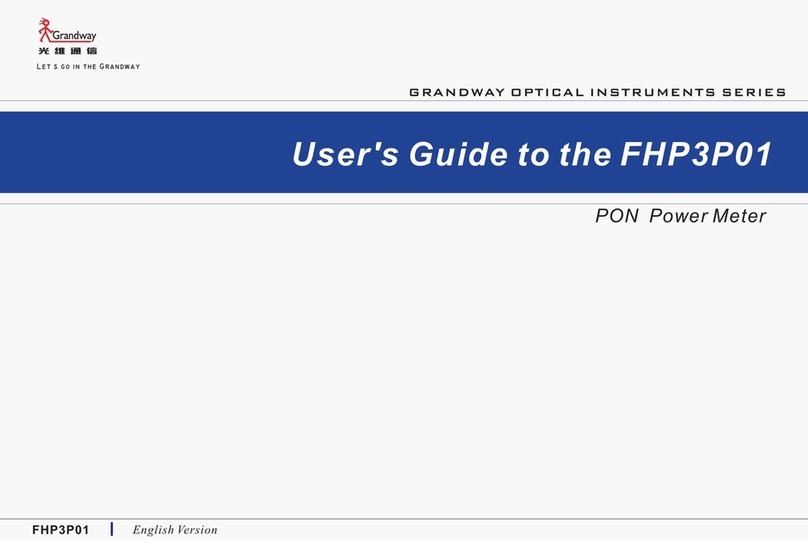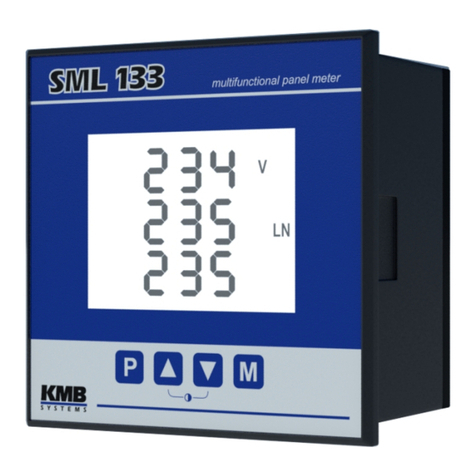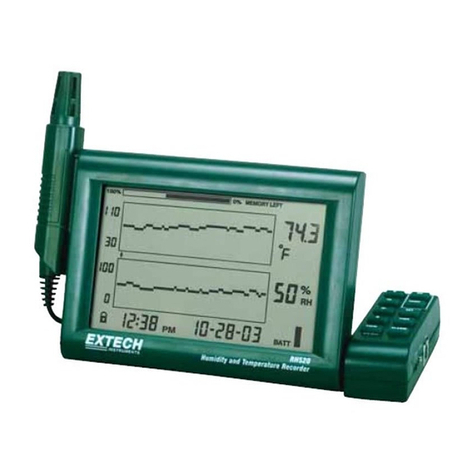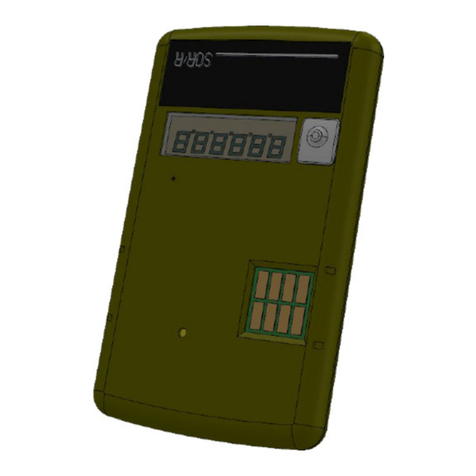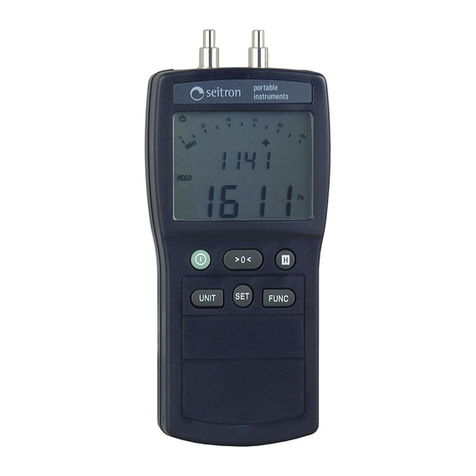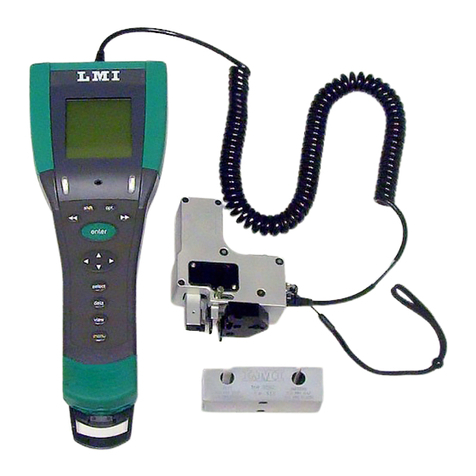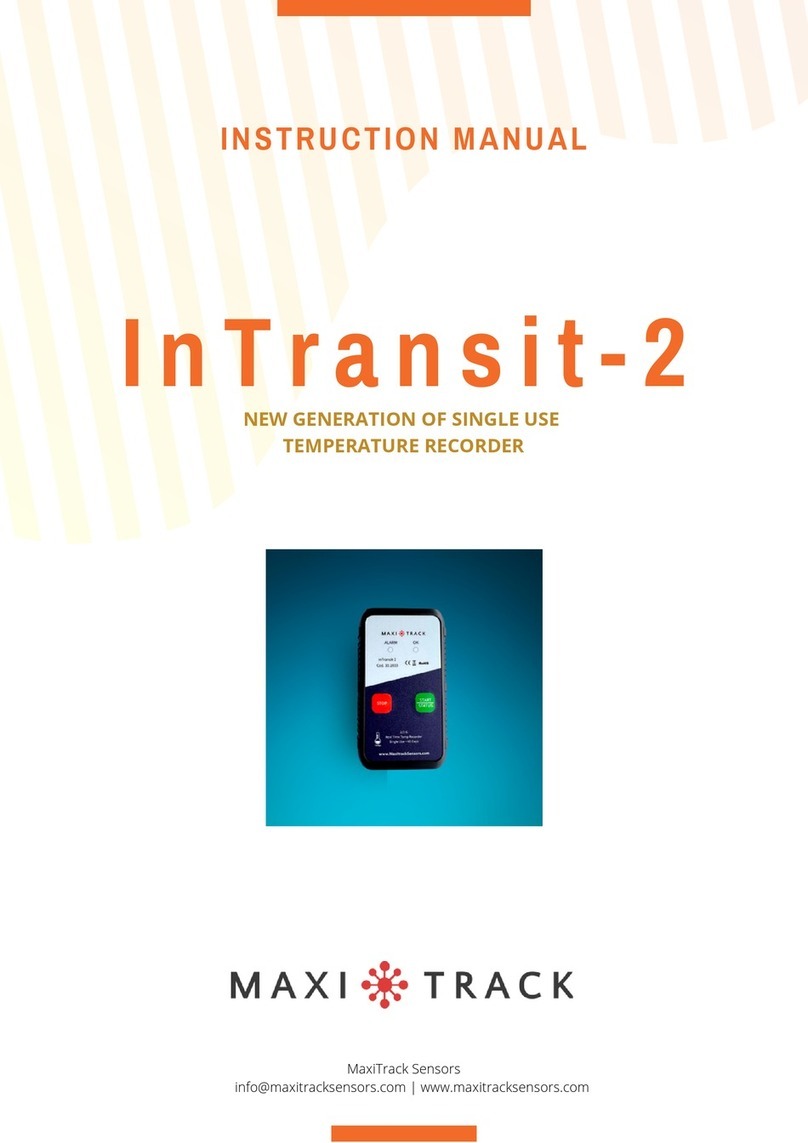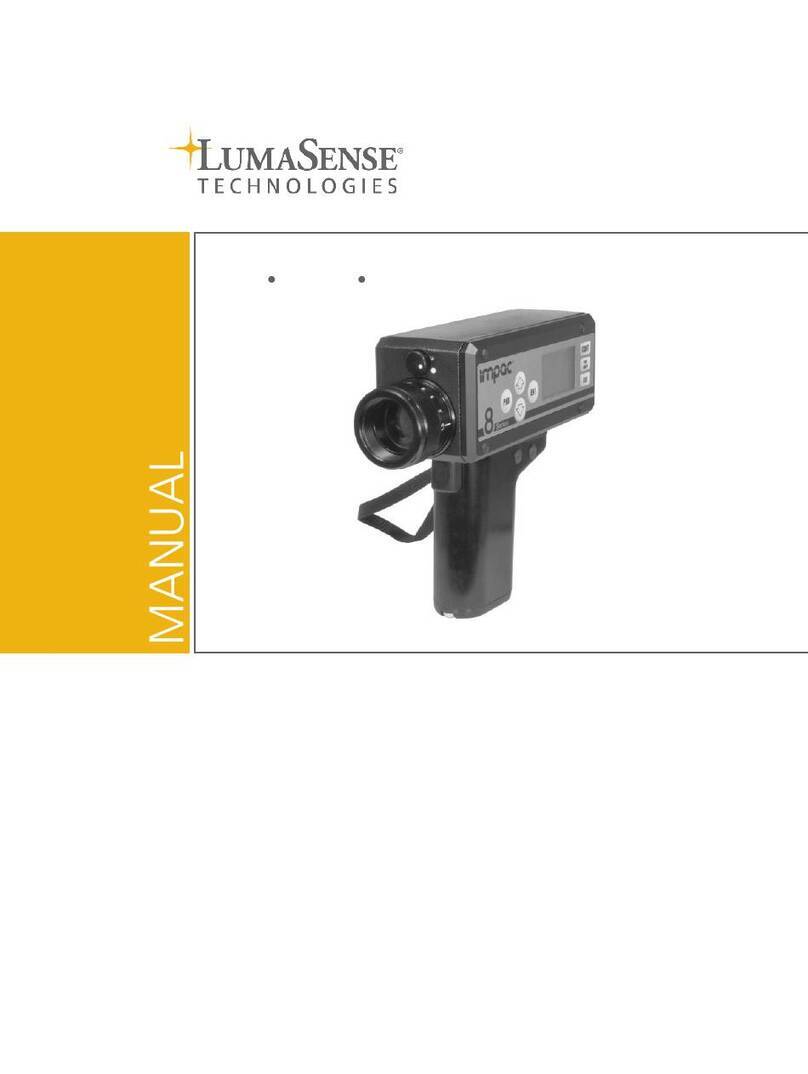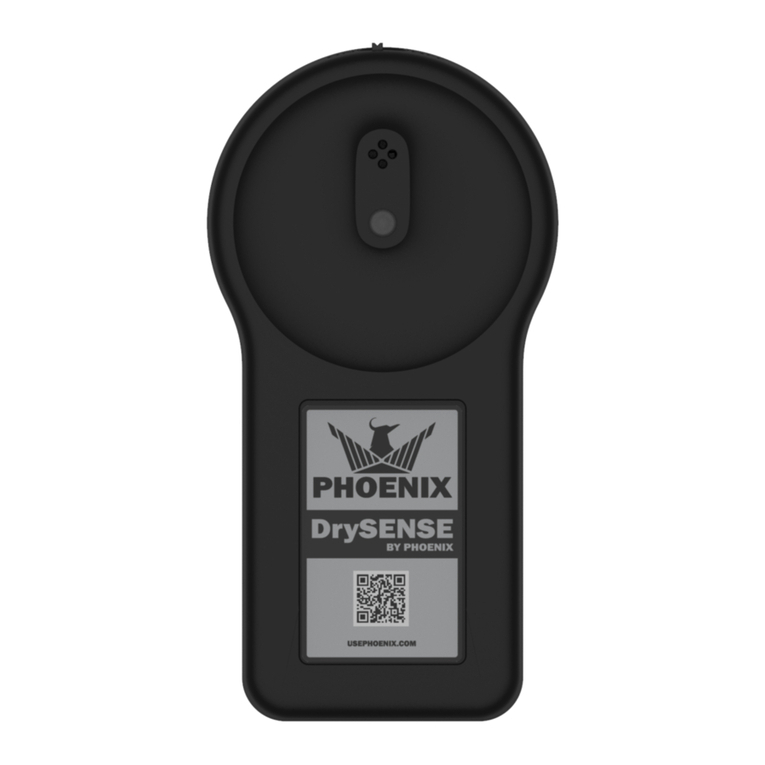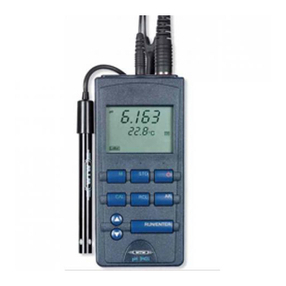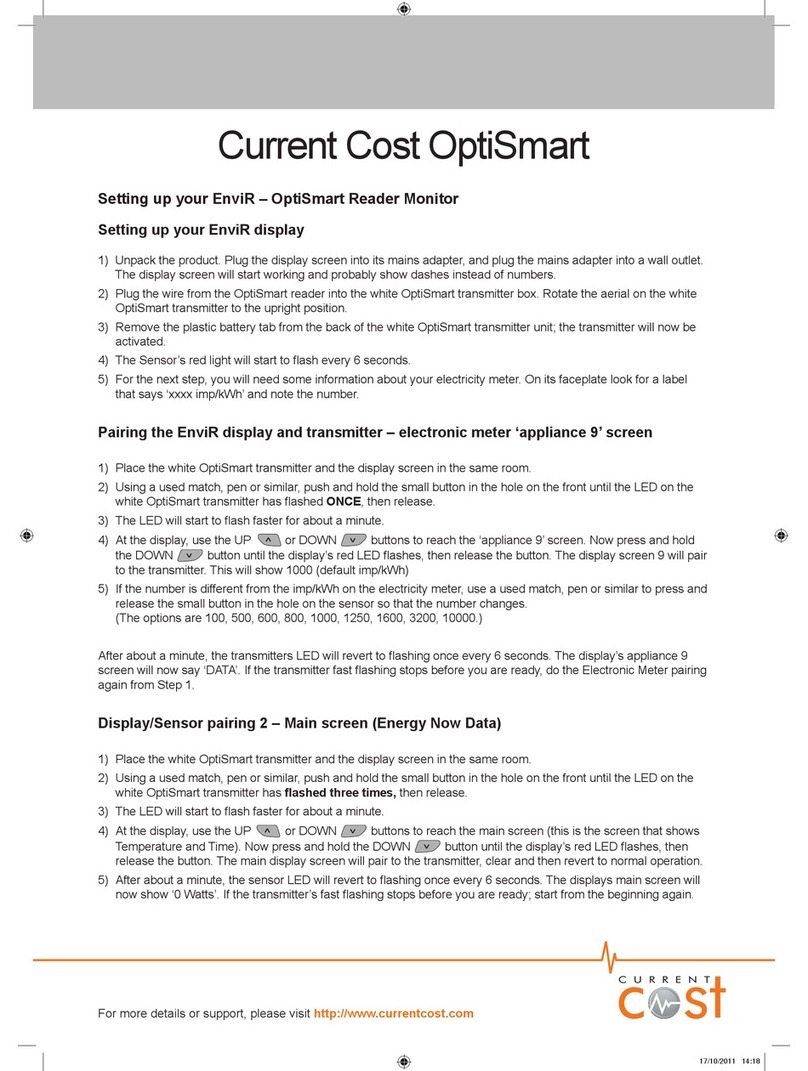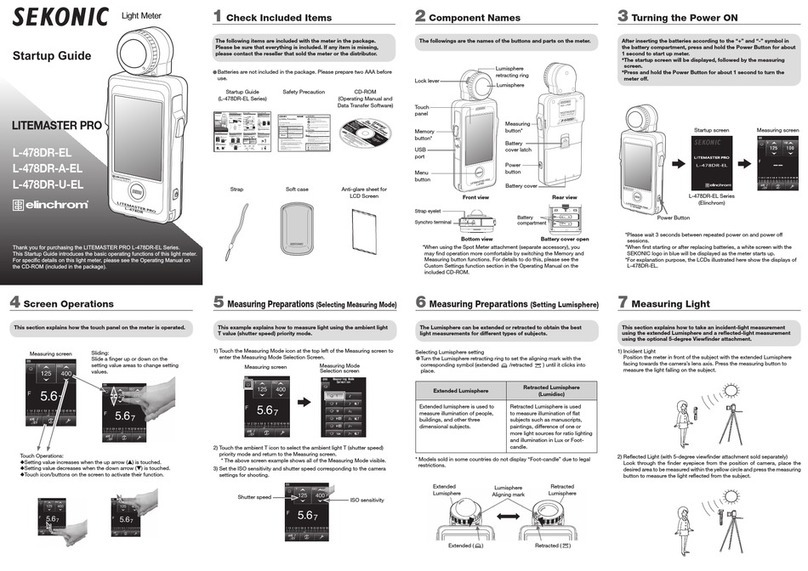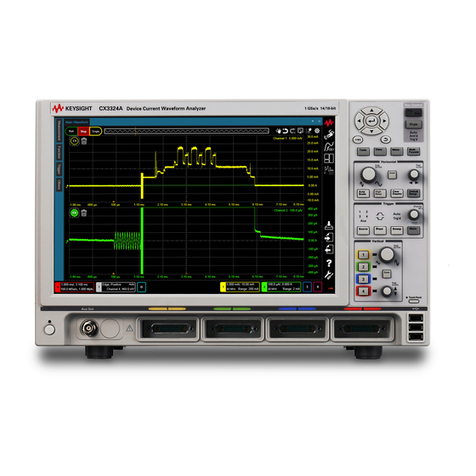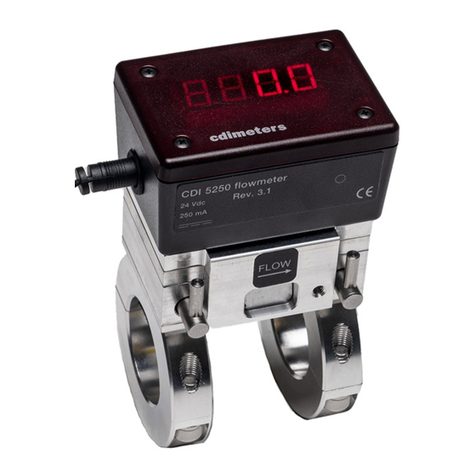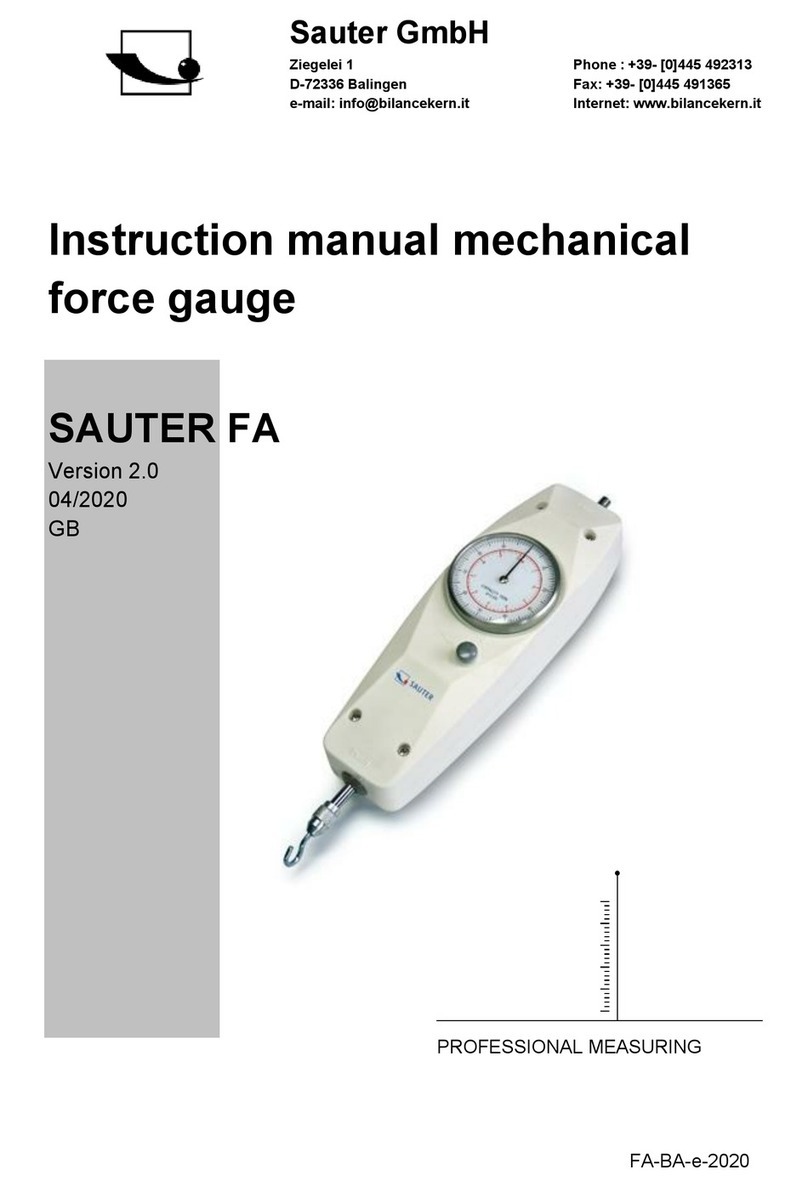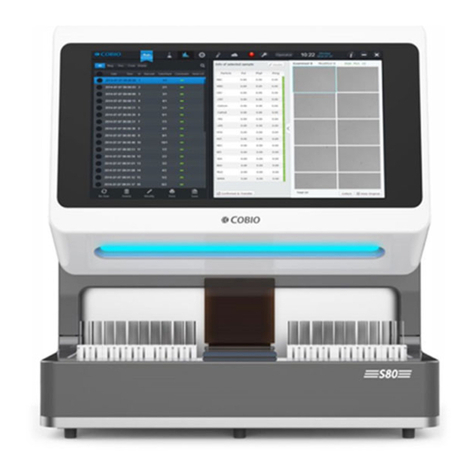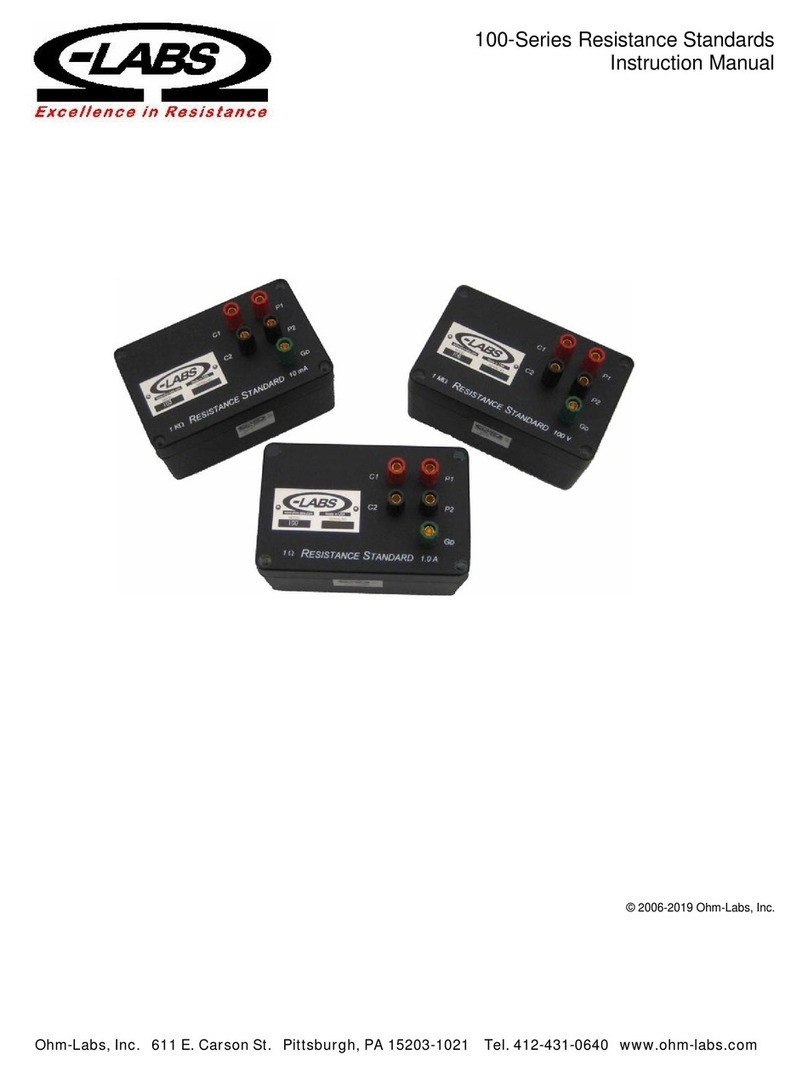Silge Electronica Red lion CUB5 User manual

1
GLCD, REFLECTIVE OR GREEN/RED LED BACKLIGHTING
G0.46" (11.7 mm) HIGH DIGITS
GOPTIONAL RELA OUTPUT MODULE
GCOUNT SPEEDS UP TO 20 KHZ (HIGH SPEED INPUT)
GOPERATES FROM 9 TO 28 VDC POWER SOURCE
GPROGRAMMABLE SCALING FOR COUNT AND RATE
GBI-DIRECTIONAL COUNTING, UP/DOWN CONTROL
GQUADRATURE SENSING (UP TO 4 TIMES RESOLUTION)
GANTI-COINCIDENCE COUNTING (ADD/ADD & ADD/SUB)
GNEMA 4X/IP65 SEALED FRONT BEZEL
GENERAL DESCRIPTION
The CUB5 provides the user the ultimate in flexibility, from it’s complete
user programming to the optional relay output capability. The meter can be
programmed as a single or dual counter with rate indication capability. The
display can be toggled either manually or automatically between the
selected displays.
The CUB5 display has .46" (11.7 mm) high digits. The LCD is available in
two versions, reflective (CUB5R ) and backlight (CUB5B ). The
backlight version is user selectable for green or red backlighting with variable
display intensity.
The counter is programmable for one of eight different count modes,
including bi-directional and quadrature. When programmed as a dual counter,
each counter has a separate scale factor and decimal points. In the counter/rate
indicator mode, each have their own scaling and decimal point read-outs in
different engineering units.
The meter has two separate inputs which provide different functions
depending on which operating mode is selected. Input A accepts the signal for
the Count and or Rate displays, while Input B accepts the signal for the Count
display or direction control. In the anti-coincidence mode, both inputs are
monitored simultaneously so that no counts are lost. The resulting display can
be chosen as the sum or difference of the two inputs. The Rate Indicator has
programmable low (minimum) and high (maximum) update times to provide
optimal display response at any input frequency. There is a programmable user
input that can be programmed to perform a variety of functions.
The capability of the CUB5 can be easily expanded with the addition of an
option module. Setpoint capability is field installable with the addition of the
CUB5RLY , relay output module.
The CUB5 can be powered from an optional Red Lion Micro-Line/Sensor
Power Supply (MLPS1 ), which attaches directly to the back of a CUB5. The
MLPS1 is powered from 85 to 25 VAC and provides up to 4 mA to drive the
unit and sensors.
COUNTER
The CUB5 receives incoming pulses and multiplies them by the Count Scale
Factor. The unit’s counter (internal count value) keeps track of the scaled input
pulse count which results in the desired reading value for the count display. Input
A accepts the signal for the count and Input B is used for quadrature, dual counter,
anti-coincidence counting, or up/down control counting.
RATE
The rate indicator utilizes the signal at Input A to calculate the rate value using
a time interval method (1/tau). The unit counts on the negative edge of the input
pulses. After the programmed minimum update time elapses and the next negative
edge occurs, the unit counts the number or edges that occurred during the elapsed
time. The number of edges is multiplied by the rate scaling value to calculate the
rate value. At slower rates, averaging can be accomplished by programming the
rate minimum update time for the desired response. Extensive scaling capabilities
allow practically any desired reading at very slow count rates.
SAFETY SUMMARY
All safety related regulations, local codes and instructions that appear in this
literature or on equipment must be observed to ensure personal safety and to
prevent damage to either the instrument or equipment connected to it. If
equipment is used in a manner not specified by the manufacturer, the protection
provided by the equipment may be impaired.
Do not use this meter to directly command motors, valves, or other actuators
not equipped with safeguards. To do so can be potentially harmful to persons or
equipment in the event of a fault to the meter.
MODEL CUB5 - MINIATURE ELECTRONIC 8-DIGIT DUAL
COUNTER AND RATE INDICATOR
Bulletin No. CUB5-X
Drawing No. LP0584
Effective 8/04
CAUTION: Read comple e
ins ruc ions prior o ins alla ion
and opera ion of he uni .
CAUTION: Risk of elec ric shock.
DIMENSIONS In inches (mm) Note: Recommended minimum clearance (behind the panel) for mounting clip installation is 2.15" (54.6) x 3.00" (76.2) W.
SILGE ELECTRONICA S.A.
Av. Mitre 950 – B1604AKN - Florida Tel. 4730-1001-Fax: 4760-4950
Email: ventas@silge.com.ar Internet: http://www.silge.com.ar

1. DISPLAY: 8 digit LCD .46" (11.7 mm) high digits
CUB5R : Reflective LCD with full viewing angle
CUB5B : Selectable transmissive red or green backlight LED with
viewing angle optimized.
2. POWER: Input voltage range is +9 to +28 VDC with short circuit and input
polarity protection. Must use an RLC model MLPS1 or a Class 2 or SELV
rated power supply.
3. MAXIMUM COUNT RATES:
4. RATE DISPLAY:
Accuracy: ± . 1%
Minimum Frequency: . 1 Hz
Maximum Frequency: 2 KHz
Maximum Display: 6 digits (999999)
5. USER INPUT: One programmable user input. Connect rear terminal to
common to activate function. Internal 1 k pull-up resistor,
Threshold Levels: VIH = 2.4 VDC min., VIL = .7 VDC max., VMAX = 28
VDC.
Response Time: 5 msec typical
6. MEMORY: Nonvolatile E2PROM memory retains all programming
parameters and count values when power is removed.
7. ENVIRONMENTAL CONDITIONS:
Oper ting Temper ture R nge for CUB5R000: -35 to 85°C
Oper ting Temper ture R nge for CUB5B000 depends on displ y color
nd intensity level s per below:
Stor ge Temper ture: -35 to 85°C
Oper ting nd Stor ge Humidity: to 85% max. relative humidity (non-
condensing)
Altitude: Up to 2 meters
8. CERTIFICATIONS AND COMPLIANCES:
Contact your Red Lion Controls’ distributor.
9. CONNECTIONS: Wire clamping screw terminals
Wire Strip Length: .3" (7.5 mm)
Wire Gage: 3 -14 AWG copper wire
Torque: 5 inch-lbs ( .565 N-m) max.
1 . CONSTRUCTION: This unit is rated for NEMA 4X/IP65 requirements for
indoor use. Installation Category I, Pollution Degree 2. High impact plastic
case with clear viewing window. Panel gasket and mounting clip included.
11. WEIGHT: 3.2 oz (1 g)
2
Ordering Information . . . . . . . . . . . . . . . . . . . . . . . . . . 2
General Meter Specifications. . . . . . . . . . . . . . . . . . . . 2
Optional Plug-In Output Card . . . . . . . . . . . . . . . . . . . 3
Installing the Meter . . . . . . . . . . . . . . . . . . . . . . . . . . . 3
Setting the DIP Switches . . . . . . . . . . . . . . . . . . . . . . . 3
Installing Plug-In Card . . . . . . . . . . . . . . . . . . . . . . . . . 4
Wiring the Meter . . . . . . . . . . . . . . . . . . . . . . . . . . . . . 4
Reviewing the Front Buttons and Display. . . . . . . . . . . 6
Programming the Meter. . . . . . . . . . . . . . . . . . . . . . . . 6
CUB5 Programming Quick Overview . . . . . . . . . . . . . 12
TABLE OFCONTENTS
GENERAL METER SPECIFICATIONS
ORDERING INFORMATION
TYPE MODEL NO. DESCRIPTION PART NUMBER
CUB5 CUB5R CUB5R000
CUB5B CUB5B000
Optional Plug-in Cards CUB5RLY Single Relay Option Card CUB5RLY0
Accessory MLPS1 Micro-Line Power Supply, 85 to 250 VAC MLPS1000
Dual Counter & Rate Indicator with Reflective Display
Dual Counter & Rate Indicator with Backlight Display
MODEL
NUMBER DISPLAY COLOR
INPUT CURRENT
WITHOUT
CUB5RLY0
INPUT CURRENT
WITH
CUB5RLY0
CUB5R000 --- 10 mA 30 mA
CUB5B000 Red (max intensity) 85 mA 115 mA
CUB5B000 Green (max intensity) 95 mA 125 mA
TEMPERATURE
1 & 2 -35 to 75°C
3-35 to 70°C
4-35 to 60°C
Red Display
5-35 to 50°C
1 & 2 -35 to 75°C
3-35 to 65°C
Green Display
5
4
-35 to 35°C
-35 to 50°C
INTENSITY LEVEL
COUNT MODE W/O SETPOINT
OPTION CARD
WITH SETPOINT
OPTION CARD
CNt ud 20 K z 20 K z
RAtE Cnt 20 K z 20 K z
dUAL Cnt 17 K z 13 K z
qUAd 1 17 K z 17 K z
qUAd 2 17 K z 17 K z
qUAd 4 17 K z 14 K z
Add Add 17 K z 16 K z
Add SUb 17 K z 16 K z

3
Adding Op ion Card
The CUB5 meters can be fitted with an optional relay card. The details for the
plug-in card can be reviewed in the specification section below. The plug-in card
can be installed initially or at a later date.
RELAY CARD
Type: Single FORM-C relay
Isol tion To Sensor & User Input Commons:
Working Voltage: 15 Vrms for 1 min.
Cont ct R ting: 1 amp @ 3 VDC resistive; .3 amp @ 125 VAC resistive
Life Expect ncy: 1 , minimum operations
Response Time:
Turn On Time: 4 msec max.
Turn Off Time: 4 msec max.
Time Accur cy: ± . 1%
WARNING: Disconnec all power o he uni before
ins alling Plug-in card.
OPTIONAL PLUG-IN OUTPUT CARD
1.0 INSTALLING THE METER
Installation
The meter meets NEMA 4X/IP65 requirements when properly installed. The
unit is intended to be mounted into an enclosed panel. Prepare the panel cutout
to the dimensions shown. Remove the panel latch from the unit. Slide the panel
gasket over the rear of the unit to the back of the bezel. The unit should be
installed fully assembled. Insert the unit into the panel cutout.
While holding the unit in place, push the panel latch over the rear of the unit
so that the tabs of the panel latch engage in the slots on the case. The panel latch
should be engaged in the farthest forward slot possible. To achieve a proper seal,
tighten the latch screws evenly until the unit is snug in the panel (Torque to
approx. 28 to 36 in-oz [ .2 2 to .26 N-m]). Do not over-tighten the screws.
Installation Environment
The unit should be installed in a location that does not exceed the operating
temperature and provides good air circulation. Placing the unit near devices that
generate excessive heat should be avoided.
The bezel should only be cleaned with a soft cloth and neutral soap product.
Do NOT use solvents. Continuous exposure to direct sunlight may accelerate the
aging process of the bezel.
Do not use tools of any kind (screwdrivers, pens, pencils, etc.) to operate the
keypad of the unit.
2.0 SETTING THE DIP SWITCHES
SETTING THE INPUT DIP SWITCHES
The meter has four DIP switches for Input A and
Input B that must be set before applying power.
SWITCHES 3 and 4
HI Frequency: Removes damping capacitor and
allows max. frequency.
LO Frequency: Adds a damping capacitor for switch
contact bounce. Also limits input frequency to 5
Hz and input pulse widths to 1 msec.
SWITCH 2
SRC.: Adds internal 3.9 KΩpull-down resistor,
7.7 mA max. @ 3 VDC max.
SNK.: Adds internal 7.8 KΩpull-up resistor to +9 to
28 VDC, IMAX = 3.8 mA.
SWITCH 1
LOGIC: Input A trigger levels VIL = 1.25 V max.; VIH = 2.75 V min.
MAG: 2 mV peak input (must also have SRC on). Not recommended with
counting applications.
To access the switches, remove the rear cover of the meter. A bank of 4
switches is located in the upper right hand corner.
W rning: Exposed line voltage exists on the circuit boards.
Remove all power to the meter and load circuits before accessing
inside of the meter.
REMOVING THE REAR COVER
To remove the rear cover, locate the cover locking tab below the 2nd and 3rd
input terminals. To release the tab, insert a small, flat blade screwdriver
between the tab and the plastic wall below the terminals. Inserting the
screwdriver will provide enough pressure to release the tab locks. To replace the
cover, align the cover with the input terminals and press down until the cover
snaps into place.
4321
ON
Input B LO Freq.
Input A LO Freq.
Input A SRC.
Input A MAG.
I Freq.
I Freq.
SNK.
Logic
Factory Setting

WIRING OVERVIEW
Electrical connections are made via screw-clamp terminals located on the
back of the meter. All conductors should conform to the meter’s voltage and
current ratings. All cabling should conform to appropriate standards of good
installation, local codes and regulations. It is recommended that the power
supplied to the meter (DC or AC) be protected by a fuse or circuit breaker.
Strip the wire, leaving approximately .3" (7.5 mm) bare lead exposed
(stranded wires should be tinned with solder.) Insert the lead under the correct
screw-clamp terminal and tighten until the wire is secure. (Pull wire to verify
tightness.) Each terminal can accept up to one #14 AWG (2.55 mm) wire, two
#18 AWG (1. 2 mm), or four #2 AWG ( .61 mm).
EMC INSTALLATION GUIDELINES
Although this meter is designed with a high degree of immunity to Electro-
Magnetic Interference (EMI), proper installation and wiring methods must be
followed to ensure compatibility in each application. The type of the electrical
noise, source or coupling method into the meter may be different for various
installations. The meter becomes more immune to EMI with fewer I/O
connections. Cable length, routing, and shield termination are very important
and can mean the difference between a successful or troublesome installation.
Listed below are some EMC guidelines for successful installation in an
industrial environment.
1. The meter should be mounted in a metal enclosure, which is properly
connected to protective earth.
2. Use shielded (screened) cables for all Signal and Control inputs. The shield
(screen) pigtail connection should be made as short as possible. The
connection point for the shield depends somewhat upon the application.
Listed below are the recommended methods of connecting the shield, in order
of their effectiveness.
a. Connect the shield only at the panel where the unit is mounted to earth
ground (protective earth).
b. Connect the shield to earth ground at both ends of the cable, usually when
the noise source frequency is above 1 MHz.
c. Connect the shield to common of the meter and leave the other end of the
shield unconnected and insulated from earth ground.
3. Never run Signal or Control cables in the same conduit or raceway with AC
power lines, conductors feeding motors, solenoids, SCR controls, and
heaters, etc. The cables should be ran in metal conduit that is properly
grounded. This is especially useful in applications where cable runs are long
and portable two-way radios are used in close proximity or if the installation
is near a commercial radio transmitter.
4. Signal or Control cables within an enclosure should be routed as far as possible
from contactors, control relays, transformers, and other noisy components.
5. In extremely high EMI environments, the use of external EMI suppression
devices, such as ferrite suppression cores, is effective. Install them on Signal
and Control cables as close to the unit as possible. Loop the cable through the
core several times or use multiple cores on each cable for additional protection.
Install line filters on the power input cable to the unit to suppress power line
interference. Install them near the power entry point of the enclosure. The
following EMI suppression devices (or equivalent) are recommended:
Ferrite Suppression Cores for signal and control cables:
Fair-Rite # 443167251 (RLC# FCOR )
TDK # ZCAT3 35-133 A
Steward # 28B2 29- A
Line Filters for input power cables:
Schaffner # FN61 -1/ 7 (RLC# LFIL )
Schaffner # FN67 -1.8/ 7
Corcom # 1 VR3
Note: Reference manufacturer’s instructions when installing a line filter.
6. Long cable runs are more susceptible to EMI pickup than short cable runs.
Therefore, keep cable runs as short as possible.
7. Switching of inductive loads produces high EMI. Use of snubbers across
inductive loads suppresses EMI.
Snubber: RLC# SNUB .
4.0 WIRING THE METER
4.1 POWER WIRING
DC Power
+9 to +28 VDC: +VDC
Power Common: -VDC
4.2 USER INPUT WIRING
Sinking Logic
INP COMM
USR
The user input of the meter is
internally pulled up to +9 to +28 V
with 1 K resistance. The input is
active when it is pulled low (< .7 V).
Connect external switching device between the
User Input terminal and Input Common.
}
4
The Plug-in card is separately purchased optional card that performs specific
functions. The card plugs into the main circuit board of the meter.
CAUTION: The Plug-in card and main circuit board contain static
sensitive components. Before handling the cards, discharge static
charges from your body by touching a grounded bare metal
object. Ideally, handle the cards at a static controlled clean
workstation. Also, only handle the cards by the edges. Dirt, oil or
other contaminants that may contact the cards can adversely
affect circuit operation.
3.0 INSTALLING PLUG-INCARD

5
4.3 INPUT WIRING
CAUTION: Power input common is NOT isolated from user input common. In order to preserve the safety of the meter application, the power input
common must be suitably isolated from hazardous live earth referenced voltage; or input common must be at protective earth ground potential. If not,
hazardous voltage may be present at the User Inputs and User Input Common terminals. Appropriate considerations must then be given to the
potential of the user input common with respect to earth ground; and the common of the plug-in cards with respect to input common.
AC Inpu s From Tach Genera ors, E c.
Inpu A
Two Wire Proximi y, Curren Source
Inpu A
Magne ic Pickup
Inpu A
Curren Sourcing Ou pu
Inpu A
In erfacing Wi h TTL
Inpu A
Curren Sinking Ou pu
Inpu A
Swi ch or Isola ed Transis or; Curren Sink
Inpu A
Swi ch or Isola ed Transis or; Curren Source
Inpu A
Switch position is application dependent.
Curren Sink Ou pu ; Quad/Direc ion
Shaded areas not recommended for counting applications.
4.4 SETPOINT (OUTPUT) WIRING
SETPOINT RELAY PLUG-IN CARD

6
5.0 REVIEWING THE FRONT BUTTONS AND DISPLAY
PROGRAMMING MODE ENTRY (SEL KEY)
It is recommended all programming changes be made off line, or before
installation. The meter normally operates in the Display Mode. No parameters
can be programmed in this mode. The Programming Mode is entered by
pressing and holding the SEL key. If it is not accessible then it is locked by
either a security code, or a hardware lock.
MODULE ENTRY (SEL & RST KEYS)
The Programming Menu is organized into four modules. These modules group
together parameters that are related in function. The display will alternate between
Pro and the present module. The RST key is used to select the desired module.
The displayed module is entered by pressing the SEL key.
MODULE MENU (SEL KEY)
Each module has a separate module menu (which is shown at the start of each
module discussion). The SEL key is pressed to advance to a particular parameter
to be changed, without changing the programming of preceding parameters.
After completing a module, the display will return to Pro NO. Programming
may continue by accessing additional modules.
SELECTION / VALUE ENTRY
For each parameter, the display alternates between the present parameter and
the selections/value for that parameter. The RST key is used to move through the
selections/values for that parameter. Pressing the SEL key, stores and activates the
displayed selection/value. This also advances the meter to the next parameter.
For numeric values, press the RST key to access the value. The right hand
most digit will begin to flash. Pressing the RST key again increments the digit
by one or the user can hold the RST key and the digit will automatically scroll.
The SEL key will advance to the next digit. Pressing and holding the SEL key
will enter the value and move to the next parameter.
PROGRAMMING MODE EXIT (SEL KEY)
The Programming Mode is exited by pressing the SEL key with Pro NO
displayed. This will commit any stored parameter changes to memory and
return the meter to the Display Mode. (If power loss occurs before returning to
the Display Mode, verify recent parameter changes.)
PROGRAMMING TIPS
It is recommended to start with Module 1 for counting or Module 2 for rate.
When programming is complete, it is recommended to record the parameter
programming and lock out parameter programming with a user input or
lock-out code.
FACTORY SETTINGS
Factory Settings may be completely restored in Module 3. This is useful
when encountering programming problems.
Pressing the RST key on power-up will load the factory settings and display
rESEt. This allows operation in the event of a memory failure or corrupted data.
ALTERNATING SELECTION DISPLAY
In the explanation of the modules, the following dual display with arrows will
appear. This is used to illustrate the display alternating between the parameter
on top and the parameter’s Factory Setting on the bottom. In most cases,
selections and values for the parameter will be listed on the right.
6.0 PROGRAMMING THE METER
OVERVIEW
PROGRAMMING MENU
Indica es Program Mode Al erna ing Display
Fac ory Se ings are shown.
Parame er
Selec ion/Value
KEY DISPLAY MODE OPERATION ENTERING PROGRAM MODE PROGRAMMING MODE OPERATION
SEL Index display through selected displays Press and hold for 2 seconds to activate Store selected parameter and index to next parameter
RST Resets count display Press SEL to enter programming mode Advances through the program menu/Increments
selected parameter value or selection
OPERATING MODE DISPLAY DESIGNATORS
“R” - To the left of the display is the rate value.
- Counter A has no designator.
“b” - To the left of the display is the Counter B value.
“1” - To the left of the display indicates the setpoint status.
Pressing the SEL button toggles the meter through the selected displays. If display scroll is enabled, the display will toggle automatically approximately every four
seconds between the rate and count values.
Cnt ud
INP A-b

7
6.1 MODULE 1 - INPUT SETUP PARAMETERS 1-INPUt)
PARAMETER MENU
COUNTER A DECIMAL POSITION
This selects the decimal point position for Counter A and the setpoint value,
if assigned to Counter A. The selection will also affect Counter A scale
factor calculations.
COUNTER A SCALE FACTOR
The number of input counts is multiplied by the scale factor to obtain the
desired process value. A scale factor of 1. will result in the display of the
actual number of input counts. (Details on scaling calculations are explained at
the end of this section.)*
00.0001 to 99.9999
COUNTER RESET AT POWER-UP
yES
NO
COUNT MODE
Select the count mode that corresponds with your application. The input
actions are located in the gray shaded area. For simple counting applications, it
is recommended to use Count with Direction for the count mode. Simply leave
the direction input unconnected.
COUNTER B DECIMAL POSITION
This selects the decimal point position for Counter B. The selection will also
affect Counter B scale factor calculations.
COUNTER B SCALE FACTOR
The number of input counts is multiplied by the scale factor to obtain the
desired process value. A scale factor of 1. will result in the display of the
actual number of input counts. (Details on scaling calculations are explained at
the end of this section.)*
00.0001 to 99.9999
Count bNO
both A-bCount A
Cnt ud qUAd 1 Add Add
dUAL Cnt
RAtE Cnt
qUAd 4
qUAd 2 Add Sub
SCALING FOR COUNT INDICATION
The CUB5’s scale factor is factory set to 1, to provide one count on the
display for each pulse that is input to the unit. In many applications, there will
not be a one-to-one correspondence between input pulses and display units.
Therefore, it is necessary for the CUB5 to scale or multiply the input pulses by
a scale factor to achieve the desired display units (feet, meters, gallons, etc.)
The Count Scale Factor Value can range from . 1 to 99.9999. It is
important to note that the precision of a counter application cannot be improved
by using a scale factor greater than one. To accomplish greater precision, more
pulse information must be generated per measuring unit. The following formula
is used to calculate the scale factor.
Scale Factor = Desired Display Units x Decimal Point Position
Number of Pulses
WHERE:
Desired Displ y Units: Count display units acquired after pulses that occurred.
Number of Pulses: Number of pulses required to achieve the desired
display units.
Decim l Point Position:
0=1
0.0 = 10
0.00 = 100
0.000 = 1000
0.0000 = 10000
0.00000 = 100000
EXAMPLE: The counter display is used to indicate the total number of feet
used in a process. It is necessary to know the number of pulses for the desired
units to be displayed. The decimal point is selected to show the resolution in
hundredths.
Scale Factor = Desired Display Units x Decimal Point Position
Number of Pulses
Given that 128 pulses are equal to 1 foot, display total feet with a one-
hundredth resolution.
Scale Factor = 1.00 x 100
128
Scale Factor = 0.007812 x 100
Scale Factor = 0.7812
0.000000.0000.0
0.00000.000
0.000000.0000.0
0.00000.000
Cnt ud
INP A-b
0
CntA dP
1.00000
CmtA Sc
0
Cntb dP
1.00000
Cntb Sc
NO
RSt P-UP
Shaded area selections only apply when programmed for dual count mode.
Counter A SubtractCounter A Add
Counter A AddCounter A Add
Quad ACount A
Quad ACount A
Quad ACount A
Counter B AddCounter A Add
Counter A AddRate only
Counter A DirectionCounter A
INPUT B ACTIONINPUT A ACTION
Add Sub 2 Input Add/Subtract
Add Add 2 Input Add/Add
qUAd 4 Quadrature x4
qUAd 2 Quadrature x2
qUAd 1 Quadrature x1
dUAL Cnt Dual Counter
RAtE Cnt Rate/Counter
Cnt ud Count with Direction
DISPLAY MODE
*For value entry instructions, refer to selection/value entry in the Programming
The Meter section.

8
6.2 MODULE 2 - RATE SETUP PARAMETERS 2-rAtE)
PARAMETER MENU
RATE ENABLE
Module 2 is the programming for the Rate parameters. For maximum input
frequency, Rate Enable should be set to NO when not in use. When set to NO, the
remaining rate parameters are not accessible. The Rate value is shown with an
annunciator of “R” in the Display Mode.
This selects the decimal point position for rate displays and any setpoint
value assigned to these displays. This parameter does not affect rate scaling
calculations.
RATE DECIMAL POINT
0.000000.0000.0
0.00000.000
RATE SCALING INPUT VALUE
RATE SCALING DISPLAY VALUE
Enter the desired Rate Display Value for the Scaling Point.*
Enter the corresponding Rate Input Value for the Scaling Point.*
0 to 999999
0 to 99999.9
*For value entry instructions, refer to selection/value entry in the Programming
The Meter section.
USER INPUT ASSIGNMENT
The User Input Assignment is only active if the meter is programmed in the
Dual Count Mode and a selection of reset, store, store and reset, or inhibit is
selected in the User Input Function menu.
USER INPUT FUNCTION
SECURITY
CODE
USER INPUT
STATE PROGRAMMING MODE ACCESS
0not Pro Loc ----- Immediate access
>0 not Pro Loc ----- After entering security code
at Pro CodE prompt
>0 Pro Loc Active After entering security code
at Pro CodE prompt
>0 Pro Loc Not Active Immediate access
0Pro Loc Active No access
0Pro Loc Not Active Immediate access
USER INPUT
FUNCTION
PROGRAMMING MODE ACCESS
MODEDISPLAY
No Function
NO
DESCRIPTION
User Input disabled.
Program Mode Lock-out
Pro Loc
Display Select
(Edge triggered)
d-SELECt Advance once for each
activation.
Maintained Reset
rESEt Level active reset of the
selected counters.
Store
StorE
Store and Reset
Stor-rSt
Inhibit
Inhibit Inhibit counting for the
selected counter(s).
d-LEVEL
Edge triggered reset of the
selected counter(s) after
storing the count. Count A
Count b
both A-b
See Programming Mode
Access chart.
Display Intensity Level
(Edge Triggered)
Freeze display for the selected
counter(s) while allowing
counts to accumulate internally.
NO
USEr INP
Count A
USEr ASN
NO
RAtE Enb
001000
RAtE dSP
O
RAtE dP
01000.0
RAtE INP
Increase intensity one level
for each activation. (backlight
version only)
Shaded area selections only apply when programmed for dual count mode.
YESNO

9
SCALING FOR RATE INDICATION
To scale the Rate, enter a Scaling Display value with a corresponding Scaling
Input value. These values are internally plotted to a Display value of and Input
value of Hz. A linear relationship is formed between these points to yield a
rate display value that corresponds to the incoming input signal rate. The meter
is capable of showing a rate display value for any linear process.
SCALING CALCULATION
If a display value versus input signal (in pulses per second) is known, then
those values can be entered into Scaling Display (RAtE dSP) and Scaling Input
(RAtE INP). No further calculations are needed.
If only the number of pulses per ‘single’ unit (i.e. # of pulses per foot) is
known, then it can be entered as the Scaling Input value and the Scaling Display
value will be entered as the following:
NOTES:
1. If # of pulse per unit is less than 1 , then multiply both Input and Display
values by 1 .
2. If # of pulse per unit is less than 1, then multiply both Input and Display
values by 1 .
3. If the Display value is raised or lowered, then Input value must be raised
or lowered by the same proportion (i.e. Display value for per hour is
entered by a third less (12 ) then Input value is a third less of # of pulses
per unit). The same is true if the Input value is raised or lowered, then
Display value must be raised or lowered by the same proportion.
4. Both values must be greater than . .
EXAMPLE:
1. With 15.1 pulses per foot, show feet per minute in tenths. Scaling Display
= 6 . Scaling Input = 15.1.
2. With .25 pulses per gallon, show whole gallons per hour. (To have greater
accuracy, multiply both Input and Display values by 1 .) Scaling Display
= 36 Scaling Input = 2.5.
INPUT FREQUENCY CALCULATION
The meter determines the input frequency by summing the number of falling
edges received during a sample period of time. The sample period begins on the
first falling edge. At this falling edge, the meter starts accumulating time
towards Low Update and High Update values. Also, the meter starts
accumulating the number of falling edges. When the time reaches the Low
Update Time value, the meter looks for one more falling edge to end the sample
period. If a falling edge occurs (before the High Update Time value is reached),
the Rate display will update to the new value and the next sample period will
start on the same edge. If the High Update Time value is reached (without
receiving a falling edge after reaching Low Update Time), then the sample
period will end but the Rate display will be forced to zero. The High Update
Time value must be greater than the Low Update Time value. Both values must
be greater than . . The input frequency calculated during the sample period, is
then shown as a Rate value determined by the scaling calculation.
The Low Update Time is the minimum amount of time between display
updates for the Rate display. Values of .1 and .2 seconds will update the
display correctly but may cause the display to appear unsteady.
RATE LOW UPDATE TIME
01.0 to 99.9 seconds
The High Update Time is the maximum amount of time before the Rate
display is forced to zero. (For more explanation, refer to Rate Value
Calculation.) The High Update Time must be higher than the Low Update Time
and higher than the desired slowest readable speed (one divided by pulses per
second). The factory setting of 2. , will force the display to zero for speeds
below .5 Hz or a pulse every 2 seconds.
RATE HIGH UPDATE TIME
0.2 to 99.9 seconds
01.0
LO-Udt
02.0
HI-Udt
# of pulses per unit3600our
# of pulses per unit60Minute
# of pulses per unit1Second
INPUT (RAtE INP)DISPLAY (RAtE dSP)
RATE PER

10
6.4 MODULE 4 - SETPOINT OUTPUT PARAMETERS 4-SEtPt)
PARAMETER MENU
The Setpoint Output Parameter is only active when the optional relay
module is installed in the meter.
Select the display the Setpoint is to be assigned.
SETPOINT OUTPUT ACTION
SETPOINT ASSIGNMENT
The yES selection allows the SEL button to toggle through the enabled
displays.
FRONT PANEL DISPLAY SELECT ENABLE (SEL)
6.3 MODULE 3 - DISPLAY AND FRONT PANEL KEY
PARAMETERS 3-dSPLAY)
PARAMETER MENU
The yES selection allows the RST button to reset the selected counter(s). The
shaded selections are only active when the meter is programmed for Dual
Count Mode.
FRONT PANEL COUNTER RESET ENABLE (RST)
The yES selection allows the display to automatically scroll through the
enabled displays. The scroll rate is about every 4 seconds.
DISPLAY SCROLL ENABLE
Enter the desired backlight color, red or green. This parameter is active for
backlight units only.
DISPLAY COLOR (BACKLIGHT UNIT ONLY)
Enter the desired Display Intensity Level (1-5). The display will actively dim
or brighten as levels are changed. This parameter is active for backlight units only.
DISPLAY INTENSITY LEVEL (BACKLIGHT UNIT ONLY)
Programming a value other than , requires the security code to be entered
before any programming changes can be made. This parameter can be
used in conjunction with the Program Mode Lock-out in the Input Setup
Parameters section.
PROGRAMMING SECURITY CODE
The yES selection will return the meter to the factory default settings. The
meter will display rESEt and then return to Pro, at which time all settings have
been changed.
Pressing the RST key on power-up will load the factory settings and display
rESEt. This allows operation in the event of a memory failure or corrupted data.
LOAD FACTORY DEFAULT SETTINGS
This parameter selects the action of the Setpoint output.
rAtECount A
LAtCH
t-OUt
bOUNd
NOyES
Count b
both A-b
dSPLAy
yES
NO
NO
Count A
NOyES
6rnrEd
0 to 999
yESNO
yES
SEL Enb
YES
RSt Enb
NO
d-ScroLL
rEd
d-COLOr
5
d-LEVEL
000
Pro CodE
MO
ACt SEt
Count A
SPt ASN
LAtCH
SPt ACt
1 to 5

11
SAVE will restore the output to the same state it was at before the meter was
powered down. ON will activate the output at power up. O will deactivate the
output at power up. This parameter is not active when the Setpoint Action is
selected for timed output mode.
SETPOINT OUTPUT POWER-UP STATE
When Counter A is reset, it returns to zero or the Setpoint Value. When the
Reset Action is selected for to SPt (Reset to Setpoint), the output activates at zero.
Boundary Mode is only active when Programmed for to ZErO (Reset to Zero).
COUNTER A RESET ACTION
SETPOINT OUTPUT TIME-OUT
SPT ACTION DESCRIPTION OUTPUT ACTIVATES OUTPUT DEACTIVATES
LAtCH Latched Output Mode When Count =
Setpoint
At Manual Reset
(if SPt rSt=YES)
t-OUt Timed Output Mode When Count =
Setpoint
After Setpoint
Output Time-Out
bOUNd Boundary Mode When Count ≥
Setpoint
When Count
< Setpoint
SETPOINT OUTPUT ACTIONS
This parameter is only active if the Setpoint Action is set to time out (t-OUt).
Enter the value in seconds that the Setpoint will be active, once the Setpoint
Value is reached.
0.01 to 99.99 seconds
SETPOINT VALUE
Enter the desired Setpoint value. To enter a negative setpoint value,
increment digit 8 to display a “-” sign.
This automatically resets the display value of Counter A each time the
Setpoint Value is reached. The automatic reset occurs at output start or end. The
Out-End is only active when setpoint output action is selected for t-OUt.
COUNTER A AUTO RESET
Select yES, so the Setpoint output will deactivate (reset) when a manual reset
is applied to the meter. Manual reset can occur by the RST button or the User
Input, if programmed for that function. When the Setpoint Assignment,
(SPt ASN) is set to Count A, this parameter only applies to Count A reset.
SETPOINT OUTPUT RESET WITH MANUAL RESET
This parameter enables the backlight CUB5 to switch the backlight color when
the Setpoint Value is reached. A reset will revert the backlight color to the normal
operating mode color. This parameter is only active for the backlight version.
CHANGE DISPLAY COLOR w/SETPOINT OUTPUT STATE
Count A: -9999999 to 99999999
Rate: 0to 999999
01.00
SPt tOUt
00000100
SPt VAL
O
SPt P-UP
to ZErO
CmtA rSt
NO
AUtO rSt
YES
SPt rSt
NO
Ch-COLOr
to SPtto ZErO
NO
Out-Strt
Out-End
NOYES
YESNO
O
ON
SAVE
LIMITED WARRANTY
The Company warrants the products it manufactures against defects in materials and workmanship
for a period limited to one year from the date of shipment, provided the products have been stored,
handled, installed, and used under proper conditions. The Company’s liability under this limited
warranty shall extend only to the repair or replacement of a defective product, at The Company’s
option. The Company disclaims all liability for any affirmation, promise or representation with
respect to the products.
The customer agrees to hold Red Lion Controls harmless from, defend, and indemnify RLC against
damages, claims, and expenses arising out of subsequent sales of RLC products or products
containing components manufactured by RLC and based upon personal injuries, deaths, property
damage, lost profits, and other matters which Buyer, its employees, or sub-contractors are or may be
to any extent liable, including without limitation penalties imposed by the Consumer Product Safety
Act (P.L. 92-573) and liability imposed upon any person pursuant to the Magnuson-Moss Warranty
Act (P.L. 93-637), as now in effect or as amended hereafter.
No warranties expressed or implied are created with respect to The Company’s products except those
expressly contained herein. The Customer acknowledges the disclaimers and limitations contained
herein and relies on no other warranties or affirmations.

CUB5 PROGRAMMING QUICK OVERVIEW
Shaded area selections are dependent on parameter mode selected.
Press and hold SEL key to
enter Programming Mode.
This manual suits for next models
2
Table of contents
